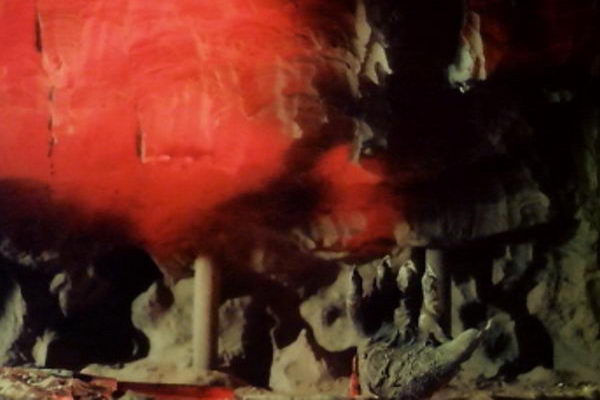|
| |
|
STORY PLACEMEN THIS STORY TAKES PLACE BETWEEN THE TV STORY "FULL CIRCLE" AND THE BIG FINISH AUDIO BOOK "THE INVASION OF E-SPACE."
PRODUCTION CODE 5P
WRITTEN BY TERRANCE DICKS
DIRECTED BY PETER MOFFATT
RATINGS 5.2 MILLION
WORKING TITLES & THE WASTING
RECOMMENDED PURCHASE 'THE E-SPACE TRILOGY' DVD BOX SET (BBCDVD 1835) RELEASED IN JANUARY 2009.
BLURB tHE DOCTOR, rOMANA AND k-9 ARE TRAPPED IN E-SPACE, A STRANGE ALTERNATIVE UNIVERSE. THEY ARE UNABLE TO FIND AN ESCAPE, AND DO NOT REALISE THAT A YOUNG BOY CALLED ADRIC HAS STOWED AWAY ABOARD THE TARDIS. ARRIVING ON A PRIMITIVE PLANET WHERE THE LOCAL INHABITANTS FEAR THE THREE WHO RULE, THEY SOON FIND THEMSELVES FACING A HIDEOUS CREATURE FROM TIME LORD LEGENDS. LONG THOUGHT DEAD, THE DOCTOR MUST CONFRONT A BLOOD-SUCKING MONSTER THAT IS VERY MUCH ALIVE... |
|
|
State of Decay 22nd november 1980 - 13th december 1980 (4 EPISODES)
Born out of Terrance Dicks’ pitch for a vampire serial to open season fifteen, “State of Decay” would ultimately form the second (and without a doubt my favourite) leg of the E-Space Trilogy.
Trust Doctor Who to run for almost eighteen years without even the merest whisper of a vampire story before hitting us with this one - a four-part serial spawning almost as much lore about Ancient Gallifrey as did “The Deadly Assassin” four years previously. Of course, at the time even the story’s writer, Terrance Dicks, could not have predicted how his Great Vampires would insidiously invade the series’ mythology from this point forth. Believe it or not, back in the spring of 1980 “State of Decay” had only the most modest of intentions…
“Work, sleep, serve the Lords well and they may let you live until you die.”
The story’s DVD release really does it justice, despite some of the special features veering a little too far from Doctor Who for my liking. “Leaves of Blood”, for instance, has absolutely nothing to do with the series or its spin-offs; it is nothing more than a seventeen-minute featurette about the history of vampirism, narrated by Big Finish supremo Nicholas Briggs and punctuated by readings from Nick Scovell (“Forty-Five”). Just about everything from Varney the Vampire to Buffy is covered - just about everything save for Doctor Who, that is. Even Steve Lyons’ recent play “Son of the Dragon” is not referenced, despite old Vlad’s name cropping up more than once. “The Blood Show” is similarly superfluous.
Conversely, Sir Christopher Flayling’s analysis of “State of Decay” is right on the money – wholly relevant and incredibly enlightening. He makes the especially interesting point that this serial combines what, at the time, where essentially two different vampire genres – the gothic and the post-modern.
I also found the flagship twenty-minute documentary, “The Vampire Lovers”, to be extremely informative, not to mention highly amusing. Christopher H Bidmead’s story about Dicks breaking down in tears saying “I’ll have to type the whole thing again!” rose a smile, but their well-documented argument over the story’s title was even funnier. Bidmead was not happy with “The Vampire Mutation” and so suggested “The Wasting”, which Dicks rejected out of hand as he felt that critics would accuse the story of “wasting everybody’s time”.
Dicks went on to write a Doctor Who novel called “Catastrophea”.
Turning to the serial itself, despite being fairly hammed-up, the four episodes are actually rather gripping. The three Vampire Lords - Aukon, Zargo and Camilla - are magnificently ghastly characters, if a tad cliché, and their hypnotic influence over Adric really makes for some compelling viewing.
What I really enjoyed about “State of Decay” though is simply how intriguing the story’s premise is. The whole planet is, as Bidmead’s title suggests, in a state of decay. Due to the oppression of the Vampire Lords, the society has not only stopped evolving but is actually locked in a state of progressive devolution.
Now that said, with the benefit hindsight it is not only possible but nigh on inevitable that “State of Decay” has been lauded as more of success than it actually was. Sandwiched as it is half-way through one of Doctor Who’s most dreadful seasons, “State of Decay” certainly stands head and shoulders above its pre-“Keeper of Traken” peers but, under close scrutiny (and certainly when weighed against some of Dicks’ earlier scripts), I do not think that it stands up all that well. For example, to me – as a fan - the best scenes in the serial see the Doctor and K-9 do a bit of research on the Great Vampires. Now it is fanwankingly wonderful to watch the Doctor learn from an old book about how the Great Vampires were defeated by Rassilon’s giant metal bowships (beautiful imagery conjured up, too), but when it comes down to watching the tower actually plunge through the heart of the Great Vampire itself, it is so below par that it is laughable – all that can be seen is a big green hand! Any story that relies more on fan-pleasing mythology and exposition than it does on action is not going to sit well with the majority of casual viewers.
At the end of the day though, I do like “State of Decay”, but I cannot resist pointing out that Dicks’ sequel to this story, his novel “Blood Harvest”, is infinitely better, as are both “Goth Opera” and “Project: Twilight” and just about every other Doctor Who vampire story that has followed since. But “State of Decay” is how it all began and, if for no other reason than
to watch the
three Vampire Lords decompose quite unpleasantly, this is a story that you
cannot really afford to miss.
|
|
|
Copyright © E.G. Wolverson 2007, 2009
E.G. Wolverson has asserted his right under the Copyright, Designs and Patents Act, 1988 to be identified as the author of this work. |
|
|
Unless otherwise stated, all images on this site are copyrighted to the BBC and are used solely for promotional purposes. ‘Doctor Who’ is copyright © by the BBC. No copyright infringement is intended. |
|

.jpg)
.jpg)
.jpg)





